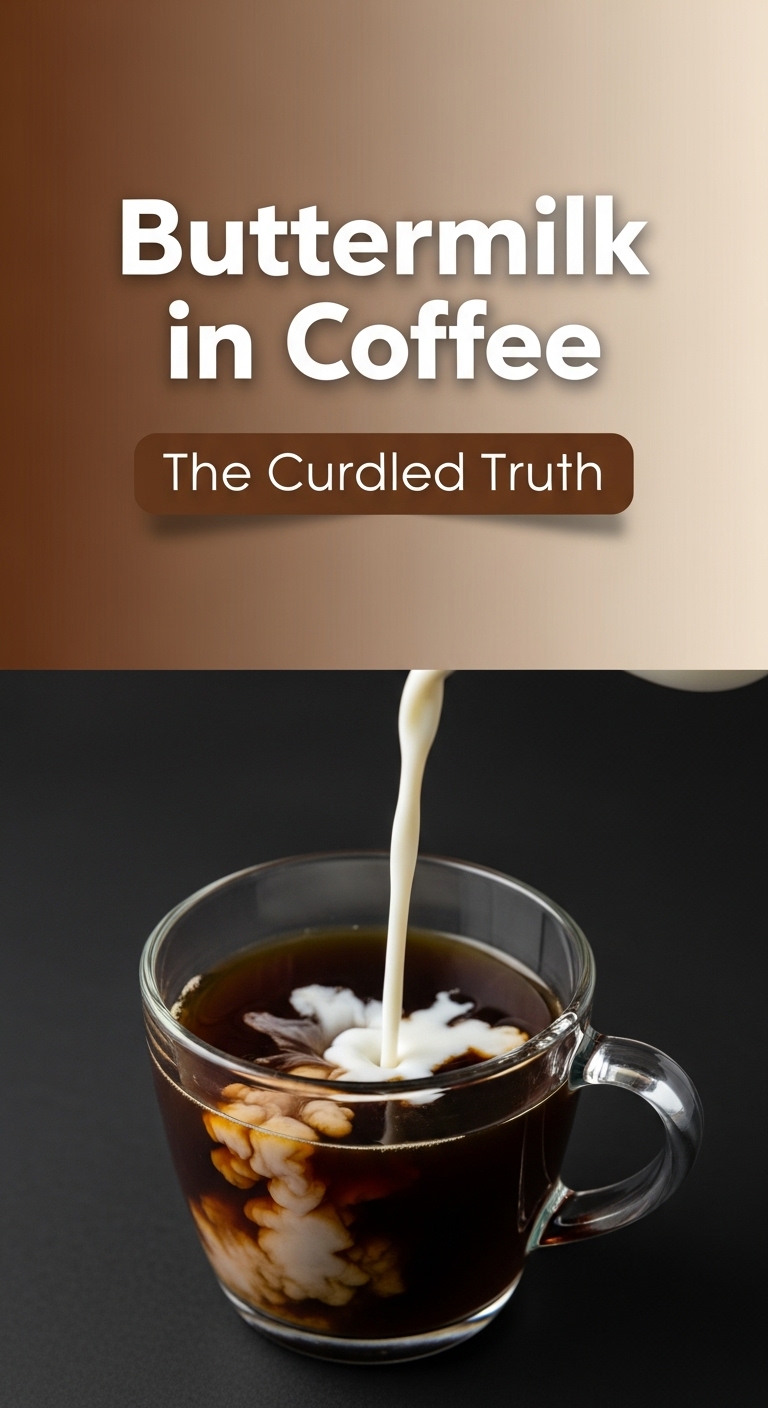As an Amazon Associate CoffeeXplore.com earns from qualifying purchases.
Buttermilk in Coffee: Here’s What Really Happens
Ever found yourself with leftover buttermilk and wondered if it could save your morning coffee? You’re not alone. The internet is full of conflicting advice, with some swearing it ruins a good cup and a growing trend suggesting it’s a secret ingredient for a creamy, tangy brew. This leaves many coffee drinkers asking the core questions: What really happens when you can use buttermilk in coffee? Will it taste good, or will it curdle into a lumpy mess?
Yes, you can use buttermilk in coffee, but it’s a controversial choice. It offers a tangy flavor and creamy texture but poses a high risk of curdling in hot coffee, making it better suited for cold brew or iced lattes.
Leveraging extensive analysis of user experiences and food science principles, this guide unpacks the surprising truth about this unusual combination. We’ll explore the science behind curdling, the actual flavor profile it creates, and provide actionable tips for those brave enough to try it. We will also cover superior alternatives and the absolute best ways to use up that leftover buttermilk so it never goes to waste.
Key Facts
- Taste Profile: The primary objection to buttermilk in coffee is its distinct tangy or sour flavor, which many people find tastes unpleasant, similar to adding Greek yogurt to their brew.
- High Curdling Risk: Buttermilk’s acidity (lactic acid) reacts with the heat and tannins in hot coffee, causing the milk proteins to clump together and create an unpleasant, grainy texture, as noted in multiple food science explanations.
- Nutritional Advantage: From a health perspective, buttermilk is lower in fat and calories than heavy cream or whole milk and contains beneficial probiotics that support gut health.
- Niche Trend: A small but growing trend, particularly on platforms like TikTok, involves creating buttermilk lattes, often using honey and sea salt to balance the tang and add what some describe as a “buttery depth,” especially in cold drinks.
- Best Alternative Use: The most popular and effective use for buttermilk is in baking. Its acidity reacts with baking soda to create exceptionally tender and fluffy pancakes, biscuits, and coffee cakes.
Buttermilk in Coffee: The Surprising Truth & What Happens Next
So, you’re standing in front of your fridge, coffee brewing, with a carton of buttermilk in hand. The big question looms: can buttermilk be used in coffee? The answer isn’t a simple yes or no. It’s a journey into flavor, texture, and a bit of kitchen science. While some purists advise against it, a growing trend suggests there might be something to this unusual pairing.
Quick Answer: Yes, you technically can, but it’s a controversial move. It delivers a unique tangy flavor and a creamy body but comes with a high risk of curdling in hot coffee. For the best results, it’s recommended for cold brew or iced coffee drinks.
Let’s break down the three critical factors you need to consider before you pour:
* Taste: Are you prepared for a sour note in your coffee? The signature tang of buttermilk is the number one reason people either love or hate this combination.
* Texture: Buttermilk is thicker than milk but not as rich as cream. The real issue is its tendency to form weird lumps or a grainy texture when it hits hot liquid.
* Temperature: This is the make-or-break variable. Hot coffee and acidic buttermilk are a recipe for curdling, while cold coffee is a much safer bet.
Understanding the Key Player: What Exactly Is Buttermilk?
Before we dive deeper into the buttermilk in coffee debate, it’s crucial to understand what you’re actually working with. The name is a bit misleading; it’s not buttery and it’s not just milk. Modern buttermilk is a fermented dairy product with a unique chemical makeup that dictates how it behaves in your cup.

Quick Fact: The ‘buttermilk’ you buy today is likely ‘cultured buttermilk,’ which is key to understanding its unique taste and texture. This isn’t the same as the liquid leftover from churning butter, which was the traditional form. Today’s version is created by intentionally adding lactic acid bacteria to milk, usually low-fat or skim. This fermented process does two things:
1. It thickens the milk, giving it a consistency somewhere between milk and yogurt.
2. It creates lactic acid, which is responsible for the distinct tangy, slightly sour flavor.
This process also makes it a source of probiotics, similar to yogurt and kefir, which can be beneficial for gut health. Nutritionally, it’s often lower in fat and calories than whole milk or cream. Here’s a quick comparison:
- Traditional Buttermilk: The thin, liquid byproduct of churning butter from cultured cream. Naturally tangy and less common today.
- Cultured Buttermilk: Milk (often low-fat) that has been pasteurized and then inoculated with live bacterial cultures. This is what you’ll find in nearly every grocery store.
Understanding that buttermilk is acidic and cultured is the key to predicting what will happen when it meets the hot, acidic environment of your coffee.
The Flavor Factor: What Does Buttermilk Taste Like in Coffee?
This is the most subjective, yet most important, part of the can buttermilk be used in coffee experiment. The flavor is polarizing. For every person who finds it adds a “buttery depth,” there are many more who feel it completely “ruins” a perfectly good cup of coffee.
The core of the flavor debate comes down to buttermilk’s signature tang. When you add it to coffee, you’re introducing a sour element that most palates aren’t accustomed to in their morning brew.
Many describe the taste as being like “unpleasant Greek or natural yogurt”, a flavor profile that clashes sharply with the roasted, rich notes of coffee.
However, there is another side to the story. A niche group of coffee enthusiasts and adventurous home baristas champion the combination, especially when other ingredients are used to balance the flavor. They claim it adds a unique richness and complexity.
Proponents note that it can add “subtly sweet characteristics” and a super creamy texture, especially when paired with honey and a pinch of sea salt in a latte.
Here’s how the two perspectives stack up:
| The Common Complaint | The Adventurous Palate |
|---|---|
| The taste is overwhelmingly sour and tangy. | The tang provides a unique, bright counterpoint. |
| It “ruins” the natural flavor of the coffee. | It adds a “buttery depth” and complexity. |
| The flavor is compared to spoiled milk or plain yogurt. | It creates a “super creamy” and rich texture. |
| It’s an unpleasant and jarring combination. | It’s surprisingly well-suited, especially in cold lattes. |
Which camp do you think you’d fall into? The traditionalist who finds it sour, or the trend-setter who finds it adds ‘buttery depth’? The only way to know for sure is to try, but it’s best to go in with realistic expectations.
The Science of Curdling: Why Buttermilk and Hot Coffee Don’t Mix
Beyond taste, the biggest technical hurdle to using buttermilk in coffee is the dreaded curdle. If you’ve ever poured it into a hot mug only to see it separate into unappetizing little white specks, you’ve witnessed a basic chemical reaction in action. This isn’t a sign the buttermilk has gone bad; it’s just science.
The unpleasant, grainy texture is caused by the proteins in the buttermilk clumping together. Here’s a step-by-step look at why this happens:
- Buttermilk is Acidic: As we’ve established, the fermentation process creates lactic acid, giving buttermilk a low pH.
- Coffee is Also Acidic (and Hot): Coffee contains natural acids and compounds called tannins. Crucially, it’s also served at a high temperature.
- The Reaction: When the acidic buttermilk is introduced to the hot, acidic coffee, it’s a perfect storm. The heat and the combined acidity cause the main protein in milk, called casein, to denature and clump together. This process is known as curdling.

Pro Tip: This is the same reason adding lemon juice to hot milk will make it curdle instantly! You’re creating the same acid-heat environment. The result is a coffee with weird lumps and a gritty mouthfeel that most people find highly unpleasant.
How to Minimize Curdling (If You’re Feeling Brave)
So, you’ve heard the warnings, but your curiosity is piqued. If you’re determined to try buttermilk in coffee, you can take a few steps to minimize the risk of a grainy disaster. The key is to reduce the shock of the temperature and acid differential.
Here are the best strategies to prevent curdling:
- Go Cold: This is the most effective method. Add buttermilk to cold brew or iced coffee. The absence of heat prevents the casein proteins from clumping, allowing you to enjoy the creamy texture and tangy flavor without the graininess.
- Cool Down: If you must use hot coffee, don’t pour the buttermilk in when it’s piping hot. Let your hot coffee cool for a few minutes before stirring in the buttermilk. Lowering the temperature significantly reduces the chance of a strong reaction.
- Temper It: This technique is borrowed from baking. Instead of pouring cold buttermilk directly into hot coffee, gently warm the buttermilk separately in a small saucepan over low heat. Then, slowly whisk a small amount of the hot coffee into the warm buttermilk before combining the two. This gradual introduction helps the proteins acclimate without seizing up.
While these methods can help, they aren’t foolproof for hot coffee. The safest and most recommended approach remains using buttermilk exclusively in chilled coffee preparations.
Better Alternatives for Your Daily Brew
If the risk of a sour, curdled cup has you reconsidering, don’t worry. There are plenty of fantastic alternatives to buttermilk in coffee that provide creaminess and richness without the drawbacks. Whether you’re looking for a dairy-based classic or a plant-based powerhouse, there’s a perfect match for your brew.
Here is a breakdown of some of the best alternatives, what they’re good for, and a pro tip for using each.
| Alternative | Best For (Flavor/Texture) | Pro Tip |
|---|---|---|
| Heavy Cream | Ultimate richness and creamy texture. A little goes a long way. | Its high-fat content makes it very stable in hot coffee and unlikely to curdle. |
| Half-and-Half | A perfect balance of creaminess without being overly heavy. | The classic, foolproof coffee companion for a smooth, traditional taste. |
| Oat Milk | The best plant-based option for creaminess and frothing. | Look for a “barista blend” oat milk, which is formulated to steam well and not separate. |
| Almond Milk | A lighter, nutty flavor with fewer calories. | Choose unsweetened versions to avoid altering your coffee’s flavor too much. |
| Butter | Creating a rich, “bulletproof” style coffee with a velvety mouthfeel. | Use unsalted butter and blend it with your coffee for a fully emulsified, creamy drink. |
| Coconut Milk | A distinct tropical flavor and thick, creamy consistency. | Full-fat canned coconut milk provides the best texture, but it will impart a strong coconut taste. |

Have a favorite from this list? Each offers a reliable and delicious way to enhance your coffee, making them much safer bets than the unpredictable nature of buttermilk.
Don’t Waste It! The Best Uses for Leftover Buttermilk
Just because buttermilk in coffee is a risky move doesn’t mean you should throw out the carton. In fact, buttermilk is a star ingredient in the kitchen, prized for its ability to create incredibly tender baked goods and flavorful savory dishes. The very acidity that makes it curdle in coffee is what makes it a powerhouse in baking.
Here are the absolute best ways to use up that leftover buttermilk:
In Baking:
* Pancakes and Waffles: This is the classic use. The acidity in buttermilk reacts with baking soda, creating carbon dioxide bubbles that result in the fluffiest, most tender pancakes you’ve ever had.
* Biscuits and Scones: Buttermilk creates flaky layers and a soft, tender crumb that’s impossible to achieve with regular milk.
* Cakes and Coffee Cakes: It adds moisture and a subtle tang that balances sweetness, keeping cakes from becoming overly sugary. That buttermilk coffee cake recipe from Taste of Home is a great place to start!
* Muffins and Quick Breads: It contributes to a moist, tender texture in everything from banana bread to corn muffins.
In Savory Cooking:
* Fried Chicken Marinades: Soaking chicken in buttermilk before frying is a classic Southern technique. The acid helps tenderize the meat, and it helps the flour coating adhere better for a super crispy crust.
* Creamy Salad Dressings: It’s the traditional base for a classic ranch or creamy blue cheese dressing, providing a tangy flavor and smooth consistency without the high fat of mayonnaise alone.
* Soups and Sauces: A splash of buttermilk can add a creamy, tangy finish to chilled soups like cucumber or hearty potato soups.
Instead of forcing it into your coffee, let buttermilk shine where it works best. You’ll get far more delicious results and no wasted food.
To truly elevate your coffee experience, especially if you’re exploring alternatives like cold brew where buttermilk works best, having the right equipment is key. Investing in a quality cold brew maker can deliver a smoother, less acidic coffee concentrate that pairs beautifully with various creamers.
FAQs About Using Buttermilk in Coffee
Navigating the world of coffee additions can bring up a lot of questions. Here are direct answers to the most common queries about using buttermilk in coffee.
Does buttermilk go well in coffee?
Generally, no. For the majority of people, the distinct sour and tangy taste of buttermilk clashes unpleasantly with the rich, roasted flavor of coffee. However, taste is subjective, and a small minority enjoys its unique creamy texture and bright flavor, particularly in iced lattes balanced with sweeteners like honey.
Will buttermilk curdle in hot coffee?
Yes, there is a very high probability that buttermilk will curdle in hot coffee. This is a chemical reaction caused by buttermilk’s high acidity (lactic acid) interacting with the heat and natural tannins in the coffee. This reaction causes the milk proteins to clump together, creating an unpleasant, grainy texture.
Is a buttermilk latte a real thing?
Yes, buttermilk lattes are a niche but growing trend, often popularized on social media. These recipes typically use cold brew or chilled espresso to avoid curdling and pair the buttermilk with honey and sea salt. This combination is said to balance the buttermilk’s tang and create a surprisingly rich, buttery flavor profile.
Can you put buttermilk in tea?
It is not recommended. Just like coffee, most hot teas contain tannins and are served at a high temperature. Adding acidic buttermilk to hot tea will likely cause the same curdling reaction, resulting in a lumpy texture and a sour taste that clashes with the delicate flavors of the tea.
Is buttermilk in coffee a healthier choice?
From a purely nutritional standpoint, buttermilk is a healthier option than heavy cream or even whole milk. It is significantly lower in fat and calories while being a good source of protein, calcium, and beneficial probiotics for gut health. However, for most people, the significant drawbacks in taste and texture outweigh these nutritional benefits.
Final Verdict: Should You Put Buttermilk in Your Coffee?
After exploring the science, the flavor profiles, and the practical outcomes, we can draw a clear conclusion on the question: can buttermilk be used in coffee? While the answer is technically yes, the more important answer is should you? For most people, most of the time, the answer is probably no.
The combination is a gamble at best. The high likelihood of curdling in hot coffee creates a grainy, unpleasant texture, and the signature sour taste is a deal-breaker for the average palate. While a niche of adventurous drinkers has found ways to make it work in chilled, sweetened lattes, it remains an outlier for a reason.
Here’s the final verdict, broken down:
* For Hot Coffee: Avoid it. The risk of curdling is too high, and the flavor combination is generally considered unpleasant. Stick to reliable alternatives like cream, half-and-half, or oat milk.
* For Cold Coffee: It’s worth a cautious experiment. If you enjoy tangy flavors and have a good cold brew, you might be one of the few who enjoy a buttermilk latte, especially with a bit of honey and salt to balance it out.
* For Your Kitchen: Absolutely keep it on hand! Buttermilk is a superstar ingredient for baking and savory cooking, where its acidity is a feature, not a bug.
Our final advice? Save that delicious, tangy buttermilk for your next batch of pancakes or coffee cake and stick to a more traditional creamer for your daily brew! You’ll get a more consistently delicious result every time.
Last update on 2025-12-05 / Affiliate links / Images from Amazon Product Advertising API

